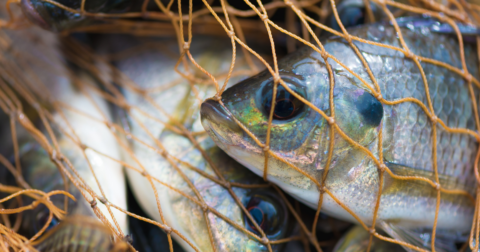News
Could Genetically Engineered Fungus Help Replace Animal Protein?
Breakthroughs•5 min read
Explainer
The research that fish feel pain, explained.


Words by Seth Millstein
The number of fish who die annually from human activities surpasses that of any other vertebrate, and yet many people still believe that it’s more ethically permissible to kill a fish than, say, a pig or a cow. This may be because fish look and behave so radically differently from humans; the underwater, otherworldly life of a fish is so distinctly inhuman that it’s difficult to believe that their experiences are in any way like ours. But their experiences are like ours — at least, as far as the scientific proof that fish also feel pain goes.
Multiple studies have demonstrated that fish both possess the anatomy necessary to produce pain and exhibit all of the standard biological responses to noxious stimuli that we would expect if they could feel pain. And if fish can feel pain, that means the fishing industry is inflicting mass suffering on an almost inconceivable scale.
“Be it recreational angling, large-scale fisheries, ornamental fish — any way that we use fish, we need to consider treating them better, as if they experience pain,” Dr. Lynn Sneddon, director of Bioveterinary Science at Liverpool University, tells Science Focus. “We should treat them with the same consideration we afford to mammals and birds.”
When one considers the sheer scale at which fish are being killed, the suffering of fish is worth dwelling on.
The simple answer is yes. Many scientific studies over many years have demonstrated that fish feel pain. To be precise, this doesn’t just mean that fish physically react to potentially injurious stimuli, but rather, that they actually experience a sensation of pain.
To begin with, fish have nociceptors, also known as pain receptors. These receptors, which humans and many other species also possess, are activated when the body is injured or exposed to potentially dangerous stimuli, such as extreme temperature or pressure. The purpose of nociceptors is to communicate to the brain, via a pain sensation, that the body is experiencing a potential threat, so that the person or animal may respond accordingly.
When fish are pricked with a pin behind their gills, their nociceptors produce a rush of electrical activity to the brain. This activity doesn’t just head to the parts of the brain that are responsible for involuntary reflexes, which is what one might expect if fish responded physically to painful stimuli but didn’t actually experience pain. The nociceptors also stimulate areas of the brain that are crucial for conscious sensory experiences, like the cerebellum, the tectum and the telencephalon.
In addition to their biology, fish behavior also suggests that they feel pain. In a study conducted by the University of Liverpool, zebrafish were given a choice of two tanks: One was barren, while the other was enriched with pleasant views of other fish and foliage. Initially, the zebrafish chose to be in the enriched tank. However, some of the fish were then injected with acid, while the barren tank was pumped full of painkillers. The fish who’d been injected with acid moved to the tank with the painkillers.
A similar study, conducted by Sneddon in 2002, sought to test fishes’ psychological states, not just their physical reactions, when exposed to pain. This time, the subjects were rainbow trout.
First, Lego blocks were dropped into their tank; under normal circumstances, a trout will avoid an unfamiliar object in its presence. But the trout in this study were injected with acid, and once they were, they stopped trying to avoid the Legos — presumably, because they were distracted by their own pain. Meanwhile, a second group of trout was injected with acid and then morphine, a powerful painkiller. The trout who received the acid and the morphine behaved as they normally would have (that is, by avoiding the Legos).
Crucially, morphine does not eliminate the source of pain, just the experience of it. The trout who received the morphine weren’t in any less danger from the acid than the other trout, and yet their behavior was completely different. This disparity in behavior only makes sense if the two groups of trout were having different experiences; the difference, Sneddon’s team concluded, is that one group of fish was experiencing pain, while the other was not.
“When subject to a potentially painful event, fishes show adverse changes in behaviour such as suspension of feeding and reduced activity,” Sneddon wrote in a 2019 meta-study of existing research, “which are prevented when a pain-relieving drug is provided.”
Naloxone is a drug that reverses the effects of morphine and other opioids. Studies have shown that when naloxone is administered to fish who’ve previously been given opioids, the effects of the opioids are inhibited or reversed, and nociception becomes active in the fish again. This further cements the fact that fish have a sensitive nervous system, whereby nociception causes a pain response in the brain that is suppressed by painkillers, and which returns if the painkillers are negated with naloxone.
Fish have also demonstrated avoidance learning, meaning that they can remember indicators of noxious stimuli and avoid them. In one 2003 study, a light was shone into a rainbow trout’s tank ten seconds before a dip net was plunged in, frightening the fish. Over a five-day period, all thirteen fish from the study learned to flee once they saw the light, but before the net actually entered the tank. This, the researchers concluded, demonstrated that fish are capable of fear, and as such, that “they are sentient animals, more complex than previously thought.”
Fish have nociceptors in their mouths, so it stands to reason that they’d feel pain when their lips are pierced with a metal hook. The science backs this up as well; in her 2019 study, Sneddon wrote that “when the fish’s lips are given a painful stimulus, they rub the mouth against the side of the tank, much like we rub our toe when we stub it.”
Suffocation is a common form of death for farmed fish. It can be an incredibly drawn-out process, with some fish species taking over an hour to die from asphyxiation. It also produces a severe stress reaction: Fish will flap, gasp, wriggle and flail while they’re asphyxiating, as they accumulate lactic acid in their muscles and succumb to rigor mortis.
But before any of this, the fish has to be lifted from the water into the air, and it’s likely this part of the process that causes them the most pain. Fish have a series of organs spanning the lengths of their bodies called the lateral line system. These organs are responsible for detecting minute changes in pressure and movement in the surrounding water, which fish use in order to navigate.
Thanks to the lateral line system, fish are extraordinarily sensitive to changes in water pressure. The rapid pressure change that occurs when a fish is pulled from the water into the air is so severe that it can rupture their organs, and is undoubtedly an excruciating process for them to endure.
Scientists have reached a consensus on the issue of fish pain, concluding that their suffering is real. But even without mountains of supporting scientific data, it would make little sense for fish to not feel pain. After all, pain avoidance is a survival mechanism, and fish seek to survive and pass on genetic material just like every other living being. They have brains, central nervous systems, and all the receptors needed to feel pain, and they exhibit all the same physiological and neurological reactions to noxious stimuli that other sentient animals do. In light of this, one would need particularly strong scientific proof to think that they don’t experience pain.
No such proof exists, and yet some people still deny the pain of fish. This is likely in part because they look and act so radically differently from humans, which makes them more difficult to relate to and empathize with. Fish are also a cornerstone of many peoples’ diets, which means it’s very inconvenient to seriously consider the possibility that they feel pain. It’s also worth noting that fish nociceptors weren’t discovered until 2002, so the science establishing that fish feel pain is relatively new.
Some have argued that because fish don’t have a neocortex — the part of the brain necessary for producing pain in humans — they must be incapable of feeling pain. But this point of view is “grossly anthropomorphic,” says Ed Yong, science reporter and author of “An Immense World: How Animal Senses Reveal The Hidden Realms Around Us,” as it “blithely assumes that the neocortex must be necessary for pain in all animals, since that’s the case in humans.” As Sneddon told Bon Appetit, the logical conclusion of this line of thought would be that “no animals except primates can experience pain.”
More to the point: for humans, the neocortex is responsible for learning, attention and sight, as well as pain. If lacking a neocortex meant fish didn’t feel pain, that would also mean they weren’t able to learn or see — which they most definitely are.
“It is clear that there is ample evidence for pain in fish,” Sneddon wrote in the Guardian. “We need to safeguard the welfare of these important animals and treat them with the same consideration that we give mammals.”
The word “cruel” denotes actions that willfully cause pain to others, and an indifference to their suffering. When we consider this definition, and mull on the fact that one does not have to eat fish to have a nutritionally sufficient and delicious diet, fishing and the consumption of fish — especially at the industrialized scale at which it occurs today — becomes much harder to justify. It causes unnecessary suffering, whereby people are willingly hurting animals when alternatives exist.
That said, there may be parts of the world where people must fish to survive.There’s also no denying that the amount of suffering caused by a single sports fisherman is minuscule when compared to that of an industrial trawler, which may kill thousands and thousands of fish — not to mention seals, birds, dolphins, and turtles who get snagged in its nets.
Yet any time someone hurts an animal when they don’t need to, they are arguably behaving cruelly. Due to humans’ affinity for seafood, fish continue to die gruesome deaths in overwhelming numbers, without any consideration for their welfare or experiences. Given the evidence that fish experience pain, the fact that humans kill trillions of them every year just might be a fact worth dwelling on.